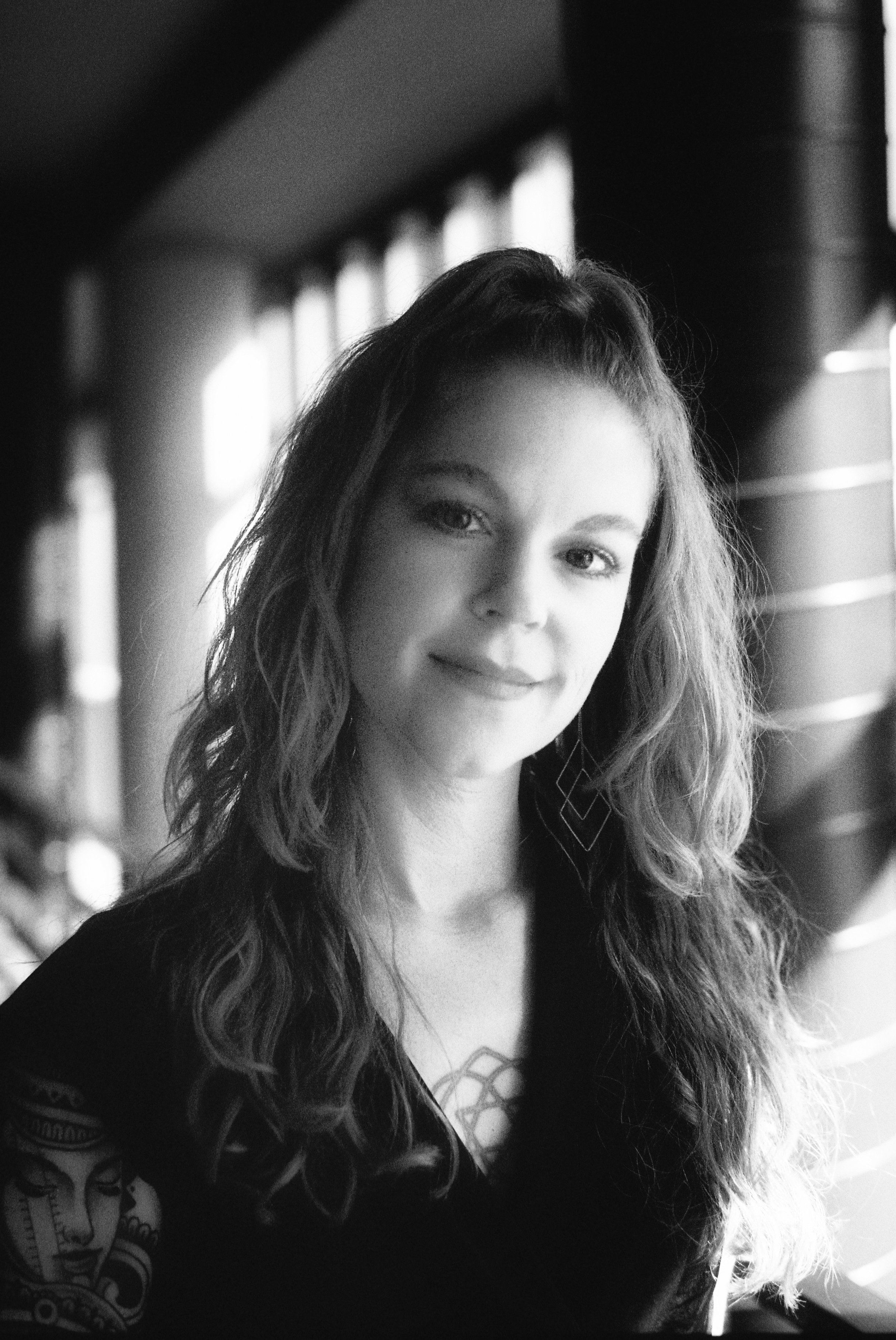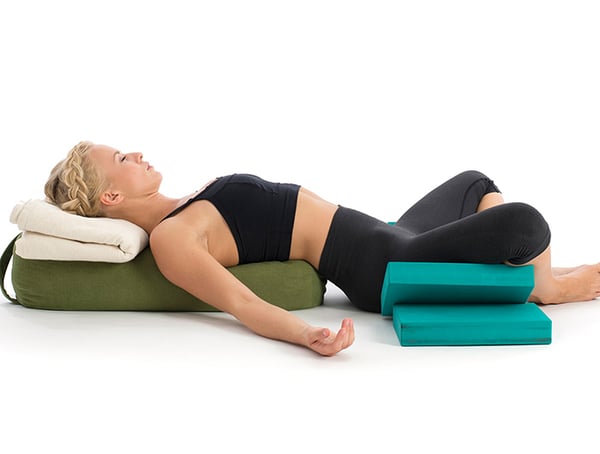
Originally appeared in the Spring 2020 Issue of American Fitness Magazine
People tend to measure themselves and their goals against certain metrics, some of which may be arbitrary. It’s quite common for individuals to obsess about personal records, weight loss, strength gains, diet fixes—the list goes on. But what if you challenged your clients and participants to consider rest as another important box to check? And what about your self-care? Have you contemplated how doing less ultimately helps you do more?
The COVID-19 pandemic has done more than just disrupt life as we knew it; it has also helped many people distill life to the essentials and focus on what really matters. One of those top priorities is health and, specifically, stress reduction.
The body is a complex weaving of multiple organ systems, and the nervous system is “the body’s electrical wiring . . . a complex collection of nerves and specialized cells” (Toro 2013). This system coordinates every activity in the body, and it is through it that we “perceive and function in the external world” (Kraftsow 1999).
In postworkout recovery, it’s important not only to bring down heart rate and allow muscles to unwind, but also to address the needs and changes of the nervous system. There are several wonderful, soothing ways to strengthen and support this system. In this article, we’ll focus on one tried-and-true method—restorative yoga.
If find this information compelling and you are considering becoming a yoga instructor, follow this link and browse our sunrise yoga program.
What Is Restorative Yoga?
Judith Hanson Lasater, PhD, PT, refers to restorative yoga as an “antidote to stress” (Shambala Publications 2011). It is, in effect, a passive form of asana sequencing that includes floor-based postures and props to support the body. Poses are generally maintained for 3–10 minutes. While a person may experience some stretch sensation, stretching is not the goal. The goal is to deeply release tension and relax. A “typical” yoga class includes a sequence of standing and seated poses, followed by restorative options such as child’s pose or savasana at the end. A restorative yoga practice includes a sequence of poses designed to support relaxation, ideally with props. B.K.S Iyengar is largely credited for developing many of the poses (Lasater 2011), and he also introduced the wide use of yoga props.
One cornerstone of any yoga practice is intention, and the intention in restorative yoga is to make the body comfortable while creating an environment that promotes total repose. That is not to say that this practice isn’t mentally challenging, however, since many people struggle to let go and surrender. It’s not unusual to discover that savasana is, in fact, the hardest pose, especially for people with a high-stress default setting.
Restorative yoga practice is designed to assist the body’s ability to switch back and forth between the parasympathetic nervous system (PNS) and the sympathetic nervous system. The former, referred to as the “rest and digest system,” is one of the autonomic nervous system’s major divisions. It is responsible for regulating many unconscious functions and “is composed of neurons located in both the brain and the peripheral nervous system that send their axons to target muscles, organs, and glands” (JoVE 2020). The PNS is also responsible for helping to maintain a calm mind, which makes it easier to remain present and focused.
Since restorative yoga is meditative in nature, it gives the practitioner an experience of physical calm and fosters the release of deeply held tension in the body. This reduces the development of secondary, stress-related problems over time. Stress, according to Lasater and other experts, can make you sick, and it begins with a physiological response to your perception that something is life-threatening. “For our ancestors, this may have been defending against the aggression of a hungry animal. For modern-day humans, this may be living with the fear of losing a job in a sagging economy, or the health crisis of a family member” (Lasater 2011).
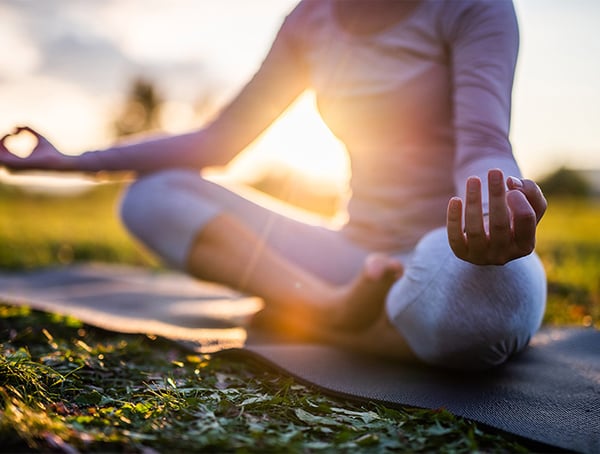
How to Apply Restorative Yoga to Mainstream Fitness
Restorative yoga is particularly beneficial for stressed-out clients who gravitate toward high-intensity activities, people who are working through injuries, and those who are trying to decompress from a major stressor like the pandemic. It is the “yin” to the “yang” found in most fitness regimens.
However, everyone can benefit from learning how to regulate the nervous system. Anecdotally, my clients have reported better sleep, greater calm under stress, and an increased ability to sense healthy alignment in their bodies when doing high-intensity or heavy-weight exercises. This not only helps them get stronger faster but instills a higher level of confidence both in and out of the gym. Some clients even report that it has helped them become more aware of their negative self-talk and suboptimal lifestyle choices; this increased awareness contributes to a healthier mind and body.
While you can certainly share restorative yoga poses at the end of a class or personal training session, this practice is best done when the body is already in a state of rest or semirest. Be mindful to lead your clients through a cooldown before taking them through a sequence.
Note that “authentic” restorative yoga uses numerous props for most poses. It is not uncommon to use six blocks, four blankets, two bolsters, one strap and a chair—just for one pose! (This has been my personal experience.) Such bounty may not be available to you, so the practice offered here relies on fewer props, if any, and resembles a yin yoga practice, which has distinct characteristics. But if possible, invest in a hearty set of yoga props (see “Typical Restorative Yoga Props,” left).
Slowing Down
One thing the COVID-19 experience has brought into full focus is the need to slow down and nurture and care for ourselves and others. Part of that is learning how to better regulate our nervous systems, especially during times of uncertainty and unrest. Yoga already offers numerous “keys” to soothe our minds and bodies, including breath work, mindful movement and, in the case of restorative yoga, deep rest. It is this deep rest that leads to a deep reset and better health and happiness.
Typical Restorative Yoga Props
According to Judith Hanson Lasater, PhD, PT, in her book Relax and Renew: Restful Yoga for Stressful Times (Shambala 2011), restorative poses are about “being rather than doing.” Key places to check for tension include the abdomen, lower back, jaw and neck. Here is a list of props you might find in a well-stocked restorative yoga practice.
- sandbags
- eye pillows/covers
- chairs
- blankets
- blocks
- bolsters
- towels
- belts or elastic straps
- wall
Sample Restorative Yoga Practice
The following sequence is an option when only a few props are available. Remember that a true restorative yoga practice relies heavily on the use of props to assist the body’s ability to truly let go.
Props:
- one large rectangular or round bolster
- three yoga blocks
- one to two blankets
- one eye pillow/cover
A yoga block can be placed at three different heights. These positions are referred to as tall, medium and short in the descriptions that follow.
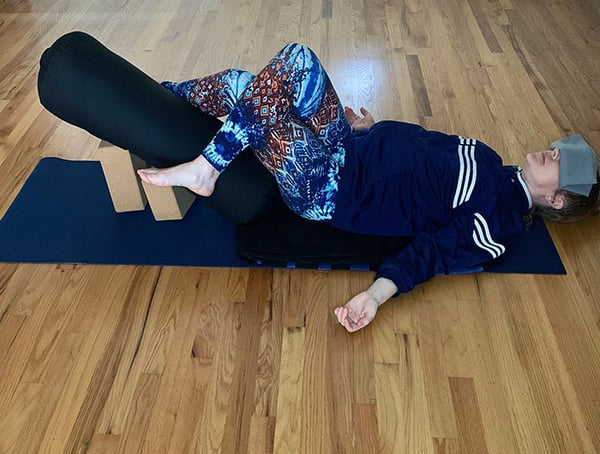
Supine Gomukhasana
Reclining Cow Face Pose (Supine Gomukhasana)
This forward-fold variation calms the nervous system and releases tension in the glutes, piriformis, iliotibial band and lower back; also, for some, the hamstrings.
- Place folded blanket on ground, ensuring it’s long enough to cushion entire torso from hips to skull.
- Place one block in tall position, with second block in medium position about 8 inches closer to blanket.
- Place bolster on blocks to create a “ramp.”
- Lie down, hips on floor close to low end of ramp.
- Cross one leg over bolster, thigh extending its length, shin hanging off opposite side.
- Cross other leg in same fashion on top of first leg. Bolster is between shins.
- Cover eyes.
- Relax and breathe deeply for 2–3 minutes, then switch orientation of legs for additional 2–3 minutes.
Bare-bones variation: Lie on back with hips about 18 inches from wall, knees bent and feet flat on wall, hip-distance apart. Cross one ankle over opposite knee in figure-four orientation. Hold for 2–3 minutes and then switch sides.
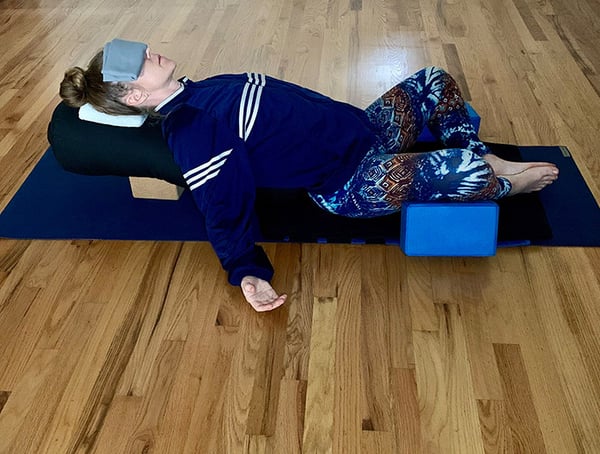
Supta Baddha
Reclining Butterfly Pose (Supta Baddha Konasana)
This pose releases tension in the pelvic floor, adductors and lower abdominals and provides
a gentle backbend to counter the repetitive flexion found in many weight-bearing exercises.
- Place block in low position and lay bolster on top of it so you have a long ramp.
- Sit on folded blanket, bolster behind you, hips touching bolster’s edge.
- Bend knees, bringing soles of feet together. Allow thighs to drop open to sides. Place block or blanket under each knee or thigh. Focus on support, not on deep stretching.
- Gently lie back onto bolster ramp, resting arms where comfortable.
- Cover eyes and breathe easily for 3–5 minutes.
Bare-bones variation: Lie on back, legs up wall. Bend knees, bringing soles of feet together so legs form diamond shape. Rest for about 3 minutes.
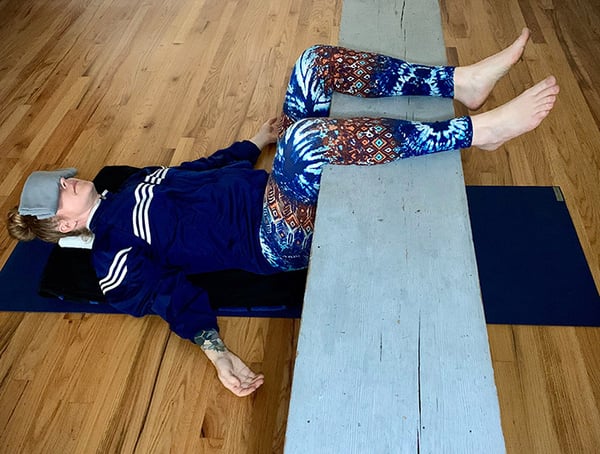
Viparita Karani Variation
Reclining Legs Up the Wall Variation (Viparita Karani Variation)
This pose relieves tension in the lower back, glutes, hip flexors, quadriceps, upper body and abdominals. It also reduces fatigue in the legs.
- Lie on folded blanket so entire torso is supported, from hips to skull.
- Place calves hip-distance apart on bench or chair, with knees bent about 90 degrees.
Position knees over or just in front of hips. Stack additional mats under torso if bench is too high or on top of bench if it is too low.
- Allow legs to soften and thighs to roll out naturally.
- Give permission for whole body to relax, breathe and rest for 3 minutes. Take your time getting up when finished.
Bare-bones variation: Lie on floor and place legs straight up wall. This requires more core action to stabilize posture but still offers plenty of benefit.
Shine Bright With AFAA’s Sunrise Yoga Specialization
Deepen your understanding of yoga with a specialization in Sunrise Yoga, a gentler, less intensive practice that’s perfect for all fitness levels. You’ll help others ease their overactive minds while reconnecting them with their bodies and breath.
Sunrise Yoga is easy to learn and enjoyable to teach, and it provides a lasting sense of calm and well-being—something that’s invaluable in today’s stressed-out society. Find out more at afaa.com/courses/sunrise-yoga.
REFERENCES
JoVE. 2020. The parasympathetic nervous system. Accessed Mar. 25, 2020: jove.com/science-education/10839/the-parasympathetic-nervous-system.
Kraftsow, G. 1999. Yoga for Wellness: Healing With the Timeless Teachings of Viniyoga. New York: Penguin Group.
Lasater, J.H. 2011. Relax and Renew: Restful Yoga for Stressful Times. Boulder, Colorado: Shambala Publications.
Toro, R. 2013. Diagram of the human nervous system. Accessed Mar. 25, 2020: livescience.com/27975-human-body-system-the-nervous-system-infographic.html.

